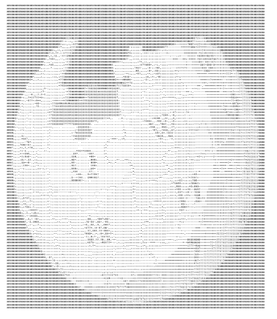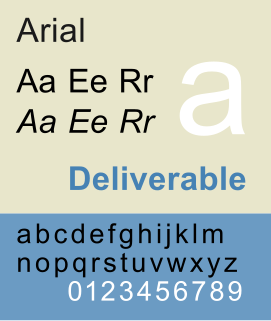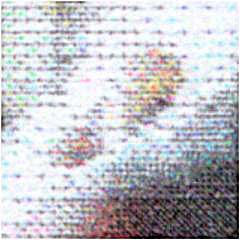
ASCII art is a graphic design technique that uses computers for presentation and consists of pictures pieced together from the 95 printable characters defined by the ASCII Standard from 1963 and ASCII compliant character sets with proprietary extended characters. The term is also loosely used to refer to text based visual art in general. ASCII art can be created with any text editor, and is often used with free-form languages. Most examples of ASCII art require a fixed-width font such as Courier for presentation.
Metafont is a description language used to define raster fonts. It is also the name of the interpreter that executes Metafont code, generating the bitmap fonts that can be embedded into e.g. PostScript. Metafont was devised by Donald Knuth as a companion to his TeX typesetting system.

Fluxbox is a stacking window manager for the X Window System, which started as a fork of Blackbox 0.61.1 in 2001, with the same aim to be lightweight. Its user interface has only a taskbar, a pop-up menu accessible by right-clicking on the desktop, and minimal support for graphical icons. All basic configurations are controlled by text files, including the construction of menus and the mapping of key-bindings. Fluxbox has high compliance to the Extended Window Manager Hints specification.

Arial, sometimes marketed or displayed in software as Arial MT, is a sans-serif typeface and set of computer fonts in the neo-grotesque style. Fonts from the Arial family are packaged with all versions of Microsoft Windows from Windows 3.1 onwards, some other Microsoft software applications, Apple's macOS and many PostScript 3 computer printers. The typeface was designed in 1982, by Robin Nicholas and Patricia Saunders, for Monotype Typography. It was created to be metrically identical to the popular typeface Helvetica, with all character widths identical, so that a document designed in Helvetica could be displayed and printed correctly without having to pay for a Helvetica license.
The BMP file format, also known as bitmap image file, device independent bitmap (DIB) file format and bitmap, is a raster graphics image file format used to store bitmap digital images, independently of the display device, especially on Microsoft Windows and OS/2 operating systems.

Dots per inch is a measure of spatial printing, video or image scanner dot density, in particular the number of individual dots that can be placed in a line within the span of 1 inch (2.54 cm). Similarly, the more newly introduced dots per centimeter refers to the number of individual dots that can be placed within a line of 1 centimeter (≈ 0.393 in).

.nfo is a commonly used filename extension for text files that accompany various digital scene releases with information about them.

GB 18030 is a Chinese government standard, described as Information Technology — Chinese coded character set and defines the required language and character support necessary for software in China. GB18030 is the registered Internet name for the official character set of the People's Republic of China (PRC) superseding GB2312. As a Unicode Transformation Format, GB18030 supports both simplified and traditional Chinese characters. It is also compatible with legacy encodings including GB2312, CP936, and GBK 1.0.
Extended Unix Code (EUC) is a multibyte character encoding system used primarily for Japanese, Korean, and simplified Chinese.

Apple Inc. uses a large variety of typefaces in its marketing, operating systems, and industrial design with each product cycle. These change throughout the years with Apple's change of style in their products. This is evident in the design and marketing of the company.
A computer font is implemented as a digital data file containing a set of graphically related glyphs, characters, or symbols such as dingbats. Although the term font first referred to a set of movable metal type pieces in one style and size, since the 1990s it is generally used to refer to a set of digital shapes in a single style, scalable to different sizes. A font family or typeface refers to the collection of related fonts across styles and sizes.
TeX font metric (TFM) is a font file format used by the TeX typesetting system. It is a font metric format, not an outline font format like TrueType, because it provides only the information necessary to typeset the font such as each character's width, height and depth. The actual glyphs are stored elsewhere. This is not unique to TeX; Adobe's AFM files and Windows' PFM files use the same technique.

misc-fixed is a collection of monospace bitmap fonts that is distributed with the X Window System. It is a set of independent bitmap fonts which—apart from all being sans-serif fonts—cannot be described as belonging to a single font family. The misc-fixed fonts were the first fonts available for the X Window System. Their individual origin is not attributed, but it is likely that many of them were created in the early or mid 1980s as part of MIT's Project Athena, or at its industrial partner, DEC. The misc-fixed fonts are in the public domain.
Windows Presentation Foundation (WPF) is a free and open-source graphical subsystem originally developed by Microsoft for rendering user interfaces in Windows-based applications. WPF, previously known as "Avalon", was initially released as part of .NET Framework 3.0 in 2006. WPF uses DirectX and attempts to provide a consistent programming model for building applications. It separates the user interface from business logic, and resembles similar XML-oriented object models, such as those implemented in XUL and SVG.
The Glyph Bitmap Distribution Format (BDF) by Adobe is a file format for storing bitmap fonts. The content takes the form of a text file intended to be human- and computer-readable. BDF is typically used in Unix X Window environments. It has largely been replaced by the PCF font format which is somewhat more efficient, and by scalable fonts such as OpenType and TrueType fonts.
Apple's Macintosh computer supports a wide variety of fonts. This support was one of the features that initially distinguished it from other systems.
PostScript fonts are font files encoded in outline font specifications developed by Adobe Systems for professional digital typesetting. This system uses PostScript file format to encode font information.

The GNU Unifont by Roman Czyborra is a free Unicode bitmap font using an intermediate bitmapped font format. The main Unifont covers the entire Basic Multilingual Plane (BMP), the "Upper" companion covers significant parts of the Supplementary Multilingual Plane, and the "Unifont JP" companion contains Japanese kanji present in the JIS X 0213 character set.

Russian Fedora Remix was a remix of the Fedora Linux distribution adapted for Russia that was active in 2008–2019. It was neither a copy of the original Fedora nor a new GNU/Linux distribution. The project aimed to ensure that Fedora fully satisfied the needs of Russian users with many additional features provided out of the box. In autumn 2019 the project was phased out because its leaders announced that it "had fulfilled it purpose by 100%" and all of the "Russian" improvements were officially included in Fedora repositories, and Russian Fedora software maintainers became regular Fedora maintainers.
Sentence spacing in digital media concerns the horizontal width of the space between sentences in computer- and web-based media. Digital media allow sentence spacing variations not possible with the typewriter. Most digital fonts permit the use of a variable space or a no-break space. Some modern font specifications, such as OpenType, have the ability to automatically add or reduce space after punctuation, and users may be able to choose sentence spacing variations.









